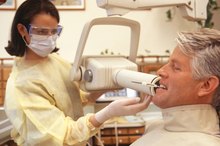What Does a Smoker's X-Ray Look Like?
A person's lungs give his body the oxygen it needs to function. Smoking is the leading cause of lung disease and the reduction of lung capacity. Knowing how smoking affects the lungs, especially after seeing an X-ray image of a smokers' lungs, may help smokers decide to quit and dissuade non-smokers from starting.
Function
X-ray machines use a beam of energy that has a very short wavelength to penetrate through a patient's body and cause an image to be formed on specially prepared film. The X-rays pass easily through soft tissue, but are blocked by dense tissue, such as bone. The image on the film is similar to a photo negative of a shadow; the dark parts of the film show where X-rays met little or no resistance and so saturated the film, while the white parts show where the rays were blocked by obstructions. In this way, physicians are able to diagnose ailments and conditions, such as the accumulation of particulate matter in a smoker's lungs.
Identification
Causes of Spots on Lungs
Learn More
This is an X-ray of a healthy patient's lungs. Note the large black areas separated by a thick white line. The lungs of non-smokers, however, are almost at as much risk for cancer or other breathing problems if they are exposed to second-hand smoke; the smoke that comes from burning tobacco or exhaled tobacco smoke. Non-smokers who are exposed to second-hand smoke should tell their physician so that the patient's lung health can be monitored.
Effects
In the lungs of smokers, the black space is usually obscured by large amounts of particulate matter, scarring, and cancer cells which are denser than the relatively-empty lungs of a healthy patient. The result is large masses or "blobs" on the X-ray. The more obstructions a patient has, the less oxygen is reaching their bodies. This may result in shortness of chronic breath, called Chronic Pulmonary Obstruction Disease (CPOD), also known as emphysema. Additionally, according to the American Lung Association, 73 percent of all smokers suffer from chronic lung disease such as CPOD or other ailments such as coronary heard disease, and stroke. 80 to 90 percent of lung cancer patients were, or still are, smokers. This X-ray shows the presence of a tumor in the patient's lung (circled in red).
Significance
Smoking & Wheezing
Learn More
According to the American Lung Association, smoking causes the air sacs in a person's lungs to rupture. These ruptures can not be seen in an X-ray and are usually revealed after the death of the smoker (see image). The lungs are also filled with other substances which the body attempts to wall off to prevent its spread. The walled-off contaminants are clearly visible as blackened areas in this image. The shape of these walled-off cells is also irregular and may make the lungs deformed over time.
Prevention/Solution
Stopping smoking is a very difficult task as nicotine is as addictive as cocaine or opiates such as heroine. A smoker may require several attempts, as well as several different approaches, to quit smoking. Smokers who have been smoking for years, or who have a heavy habit, are often tapered off tobacco through nicotine-laden gums, patches, or injections under the supervision of a physician. For those who do quit, the risk of lung cancer and other lung diseases drops dramatically, though their lungs will never return to the "healthy" state they were in prior to smoking. Damaged cells will remain with patients for the rest of their lives, but people who quit smoking reduce their chances of cancer by 20 to 40 percent.
Related Articles
Resources
Writer Bio
Michael Hinckley received a Bachelor of Arts degree in US history from the University of Cincinnati, a Master of Arts degree in Middle East history from the University of California at Santa Barbara. Hinckley is conversant in Arabic, and is a part-time lecturer at two Midwestern universities.







